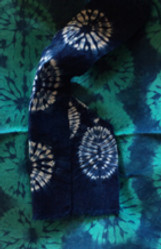Surface Design Workshops
Contact me for focused shibori workshops which require previous dye experience.
Why is indigo so magical? Because it dates to ancient Egypt? Because the blue develops on contact with air and repeated dipping makes the blue seem like many colors? Indigo's magic is the perfect partner to shibori. We’ll use smaller indigo vats that are more practical for most people’s time and space. Pre-reduced indigo mimics the original plant source and assures results.
These two workshops can be scheduled separately or as a 5-day workshop. No experience is necessary; experienced dyers are welcome.
Introduction to Indigo (1-2 days) Experience the magic and learn about the care and feeding of an indigo vat, using synthetic indigo. We'll create indigo samples of basic shibori patterns, suitable for sampler quilts and other projects.
Perfect Union (3 days) Shibori & indigo dyeing have brought out the best in each other for centuries. A Perfect Union begins where the Introduction left off. After a quick review, we’ll explore some of shibori’s seemingly endless variations, with an emphasis on individual attention and experimentation. A brief history of indigoand shibori will be included.


Shibori Indigo: Introduction & Perfect Union

(new)Maximum Resist: Indigo Shibori (5 days)
Explore a unique grouping of shibori techniques which maximize shibori’s resist. Instead of flooding fabric with indigo, backgrounds are reserved to showcase diverse patterns that are not commonly grouped in a single workshop. Stitched fabric bound to rope creates elegant yanagi (willow) and midori (willow leaf). Stitching bound to a pvc pipe becomes delicate shirokage (white shadow) or energetic hinode (sunrise variations). And bold sekka (snow flower) patterns rely on blocks. Unique reverse patterns include tako boshi (octopus) capping, hasu ami (diamond net) on pvc pipe and reverse looped binding (ura miura) on rope. These are just a few of the many possibilities. All levels are welcome.


Indigo Shibori: Beyond Blue (5 days)
Experience the excitement of dyeing indigo patterns over color. Results can range from dramatic to subtle, with an added bonus when the interaction of indigo and fiber reactive dyes create interesting haloes of color. The class will include instruction on using the dyes as well as shibori techniques with lots of time to create beautiful, unique fabrics. No experience is necessary; experienced dyers are welcome




Potatoes & Poles: Dextrin Crackle & Arashi Interrupted (3-5 days)
Experiment with the organic patterns produced by these two resists. When potato dextrin dries, its crackled surface is dye painted to create textures from fine veins to bold webs, reminiscent of batik. In arashi, poles (pvc pipes) are wrapped with fabric and compressed into folds that are manipulated in myriad ways (mechanically, paste resists, reverses, etc.) creating patterns of “regular irregularity." The focus will be cotton samples using fiber reactive and indigo dyes.
Traditional Japanese Slow Stitch: Shibori & Boro


If you love to stitch, come experience these amazing age-old Japanese traditions of hand sewing. Though shibori and boro both rely on, but are not limited to, simple running stitches, the results are elegant and complex.Create new indigo-dyed cloth with shibori, where stitches are sewn, gathered and dyed. Designs are revealed as stitches are removed. Then turn to boro, a tradition of patching and mending ( "country sashiko)," where layers of fabrics are exuberantly hand stitched to create new cloth. Our boro will use fabrics dyed in class and brought from home.. Quilting the layers with batting is optional. Students at all levels are welcome.


Take the familiar term “origami” that is the Japanese tradition of paper folding, and insert their word for dyeing, “zome,” and you get “orizomegami”, the art of dyeing folded paper. The folds are easy and patterns come from dipping paper in non-toxic water colors. The techniques are similar to those used on fabric (itajime), but instead of clamps, orizomegame simply uses finger pressure to control the patterns. We’ll dye tissue paper, useable for gift wrapping, and heavier rice paper suitable for cards, etc.
Orizomegame: Paper Dyeing (1/2 or 1 day)

Fabric Stamping (1 day)
Add pizzazz to the textiles in your life. Print your own unique patterns with stamps that are store bought, or fashioned from everyday objects, or quickly carved from erasers or simply constructed with glue. The materials are inexpensive and non-toxic, basic techniques are easily learned and the results are immediate. Design theory is introduced as students create their own styles from elegant restraint to outrageous and funky.

Colorful Quarters (1-3 Days)
If you're a beginner or experienced, join us for a day of dyeing fat quarters using fiber reactive dyes. One day one learn to mix dyes all around tthe color wheel, from color to color and from light to dark. With additional days, we'll dye mottled colors in baggies and mix more colors. Depending on the number of students, in two or three days, you'll end up with as much as 5 yards of cotton, suitable for quilting projects. Our focus will be repeatable results. Never run out of a fabric again!